
(a)
Interpretation:
The complete, detailed mechanism for the given reaction is to be drawn and the product is to be predicted.
Concept introduction:
A weak acid can add to an
Answer to Problem 11.11P
The complete mechanism of the given addition reaction is

The product of the reaction is

Explanation of Solution
The given addition reaction is

Water is a weak acid and does not add to the alkene in neutral conditions. In the presence of the strong acid HCl, water is protonated to

This is the electrophilic addition step. In the next step, a molecule of water acts as a nucleophile and attacks the carbocation to form protonated alcohol.

Final deprotonation by another molecule of water gives the final product, cyclohexanol.

Thus, the complete mechanism for the reaction can be drawn as

And the product of the reaction is cyclohexanol

Weak Bronsted acids can add to an alkene in the presence of a strong acid.
(b)
Interpretation:
The complete, detailed mechanism for the given reaction is to be drawn and the product is to be predicted.
Concept introduction:
A weak acid can add to an alkene in the presence of a strong acid. Because of the leveling effect, the protonated form of a weak acid is the strongest acid that can exist, so the strong acid protonates the weak acid. This protonated form of the weak acid is a good electrophile because of the positive charge. The double bond in the alkene is an electron-rich region and behaves as a nucleophile. The
Answer to Problem 11.11P
The complete mechanism for the given addition reaction is

The product of the reaction is
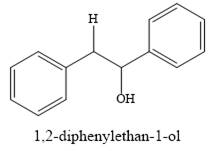
Explanation of Solution
The given addition reaction is
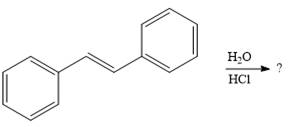
In the presence of HCl, the weak acid

In the next step, a molecule of water acts as a nucleophile and adds to the carbocation to form a protonated alcohol.

In the final step, another molecule of water deprotonates to give the final product,
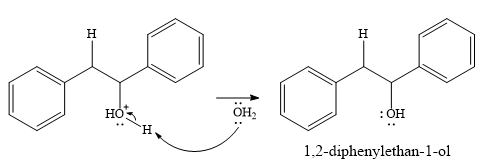
Thus, the complete mechanism for this addition reaction can be drawn as
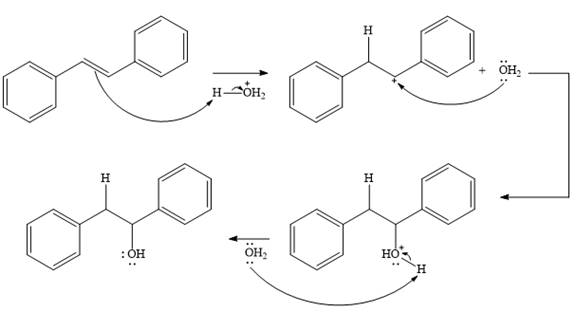
And the product of the reaction is

Weak Bronsted acids can add to an alkene in the presence of a strong acid.
(c)
Interpretation:
The complete, detailed mechanism for the given reaction is to be drawn and the product is to be predicted.
Concept introduction:
A weak acid can add to an alkene in the presence of a strong acid. Because of the leveling effect, the protonated form of a weak acid is the strongest acid that can exist, so the strong acid protonates the weak acid. This protonated form of the weak acid is a good electrophile because of the positive charge. The double bond in the alkene is an electron-rich region and behaves as a nucleophile. The
Answer to Problem 11.11P
The complete mechanism for the given addition reaction is

The product of the reaction is
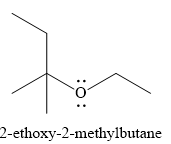
Explanation of Solution
The given reaction is

In the presence of a strong acid
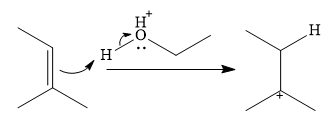
In the next step, a molecule of ethanol will act as a nucleophile and form a bond with the carbocation, using a lone pair on oxygen.

This results in the formation of protonated ether, which is deprotonated by another molecule of ethanol in the final step.

Thus, the complete mechanism for this addition reaction can be drawn as

And the product of the reaction is
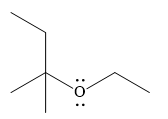
Weak Bronsted acids can add to an alkene in the presence of a strong acid.
(d)
Interpretation:
The complete, detailed mechanism for the given reaction is to be drawn and the product is to be predicted.
Concept introduction:
A weak acid can add to an alkene in the presence of a strong acid. Because of the leveling effect, the protonated form of a weak acid is the strongest acid that can exist, so the strong acid protonates the weak acid. This protonated form of the weak acid is a good electrophile because of the positive charge. The double bond in the alkene is an electron-rich region and behaves as a nucleophile. The
Answer to Problem 11.11P
The complete mechanism for the reaction is

The product of the reaction is
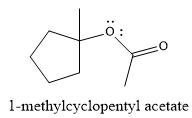
Explanation of Solution
The given reaction is
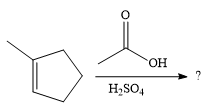
In the presence of
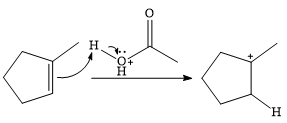
In the next step, a molecule of acetic acid will act as a nucleophile using a lone pair on OH oxygen to form a bond with the carbocation. The result is a protonated form of the ester product.

Final deprotonation by another molecule of acetic acid will give the product.

Thus, the complete mechanism for the reaction can be drawn as

The product of the reaction is

Weak Bronsted acids can add to an alkene in the presence of a strong acid.
Want to see more full solutions like this?
Chapter 11 Solutions
Organic Chemistry: Principles and Mechanisms (Second Edition)
- Experiment 27 hates & Mechanisms of Reations Method I visual Clock Reaction A. Concentration effects on reaction Rates Iodine Run [I] mol/L [S₂082] | Time mo/L (SCC) 0.04 54.7 Log 1/ Time Temp Log [ ] 13,20] (time) / [I] 199 20.06 23.0 30.04 0.04 0.04 80.0 22.8 45 40.02 0.04 79.0 21.6 50.08 0.03 51.0 22.4 60-080-02 95.0 23.4 7 0.08 0-01 1970 23.4 8 0.08 0.04 16.1 22.6arrow_forward(15 pts) Consider the molecule B2H6. Generate a molecular orbital diagram but this time using a different approach that draws on your knowledge and ability to put concepts together. First use VSEPR or some other method to make sure you know the ground state structure of the molecule. Next, generate an MO diagram for BH2. Sketch the highest occupied and lowest unoccupied MOs of the BH2 fragment. These are called frontier orbitals. Now use these frontier orbitals as your basis set for producing LGO's for B2H6. Since the BH2 frontier orbitals become the LGOS, you will have to think about what is in the middle of the molecule and treat its basis as well. Do you arrive at the same qualitative MO diagram as is discussed in the book? Sketch the new highest occupied and lowest unoccupied MOs for the molecule (B2H6).arrow_forwardQ8: Propose an efficient synthesis of cyclopentene from cyclopentane.arrow_forward
- Q7: Use compound A-D, design two different ways to synthesize E. Which way is preferred? Please explain. CH3I ONa NaOCH 3 A B C D E OCH3arrow_forwardPredict major product(s) for the following reactions. Note the mechanism(s) of the reactions (SN1, E1, SN2 or E2).arrow_forward(10 pts) The density of metallic copper is 8.92 g cm³. The structure of this metal is cubic close-packed. What is the atomic radius of copper in copper metal?arrow_forward
- Predict major product(s) for the following reactions. Note the mechanism(s) of the reactions (SN1, E1, SN2 or E2).arrow_forwardPredict major product(s) for the following reactions. Note the mechanism(s) of the reactions (SN1, E1, SN2 or E2).arrow_forwardQ3: Rank the following compounds in increasing reactivity of E1 and E2 eliminations, respectively. Br ca. go do A CI CI B C CI Darrow_forward
- Q5: Predict major product(s) for the following reactions. Note the mechanism(s) of the reactions (SN1, E1, SN2 or E2). H₂O דיי "Br KN3 CH3CH2OH NaNH2 NH3 Page 3 of 6 Chem 0310 Organic Chemistry 1 HW Problem Sets CI Br excess NaOCH 3 CH3OH Br KOC(CH3)3 DuckDuckGarrow_forwardQ4: Circle the substrate that gives a single alkene product in a E2 elimination. CI CI Br Brarrow_forwardPlease calculate the chemical shift of each protonsarrow_forward
 ChemistryChemistryISBN:9781305957404Author:Steven S. Zumdahl, Susan A. Zumdahl, Donald J. DeCostePublisher:Cengage Learning
ChemistryChemistryISBN:9781305957404Author:Steven S. Zumdahl, Susan A. Zumdahl, Donald J. DeCostePublisher:Cengage Learning ChemistryChemistryISBN:9781259911156Author:Raymond Chang Dr., Jason Overby ProfessorPublisher:McGraw-Hill Education
ChemistryChemistryISBN:9781259911156Author:Raymond Chang Dr., Jason Overby ProfessorPublisher:McGraw-Hill Education Principles of Instrumental AnalysisChemistryISBN:9781305577213Author:Douglas A. Skoog, F. James Holler, Stanley R. CrouchPublisher:Cengage Learning
Principles of Instrumental AnalysisChemistryISBN:9781305577213Author:Douglas A. Skoog, F. James Holler, Stanley R. CrouchPublisher:Cengage Learning Organic ChemistryChemistryISBN:9780078021558Author:Janice Gorzynski Smith Dr.Publisher:McGraw-Hill Education
Organic ChemistryChemistryISBN:9780078021558Author:Janice Gorzynski Smith Dr.Publisher:McGraw-Hill Education Chemistry: Principles and ReactionsChemistryISBN:9781305079373Author:William L. Masterton, Cecile N. HurleyPublisher:Cengage Learning
Chemistry: Principles and ReactionsChemistryISBN:9781305079373Author:William L. Masterton, Cecile N. HurleyPublisher:Cengage Learning Elementary Principles of Chemical Processes, Bind...ChemistryISBN:9781118431221Author:Richard M. Felder, Ronald W. Rousseau, Lisa G. BullardPublisher:WILEY
Elementary Principles of Chemical Processes, Bind...ChemistryISBN:9781118431221Author:Richard M. Felder, Ronald W. Rousseau, Lisa G. BullardPublisher:WILEY





